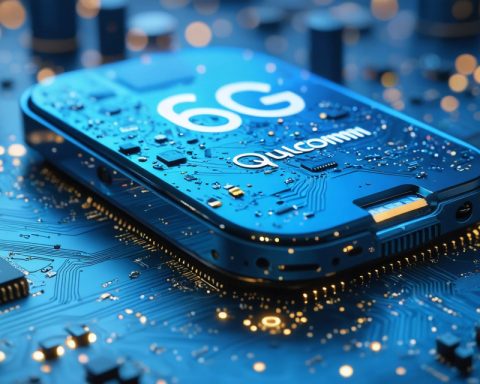- The wireless industry is focused on advancing to 6G, with Qualcomm leading efforts in capacity, cost, and coverage optimization.
- The 3GPP workshop has been pivotal in generating transformative ideas for 6G development.
- Qualcomm envisions robust networks to support immersive technologies like AR and VR, emphasizing high throughput and low latency.
- Innovative ventures include non-terrestrial networks (NTNs), enhancing coverage by integrating satellite and terrestrial networks.
- Efforts to reduce the total cost of ownership involve network simplification, energy efficiency, and AI-native systems.
- Qualcomm aims to integrate sensing, AI-enhanced services, and immersive computing for expansive opportunities beyond connectivity.
- Collaboration across the ecosystem is essential, positioning Qualcomm as both a pioneer and a unifier in the 6G landscape.
- Qualcomm’s 6G innovations promise intelligent, efficient, and inclusive digital experiences in the future.
Amid the relentless rush of technological progress, the wireless industry is setting its sights on an ambitious new frontier: 6G. Ushering in this next generation of connectivity, Qualcomm stands at the helm, navigating between the ever-growing demands for high-capacity networks and operators’ concerns over costs. The ongoing dialogue surrounding 6G, fueled by gatherings like the 3GPP workshop in March, is sparking transformative ideas set to shape the digital landscape of the 2030s.
At the heart of Qualcomm’s strategy lies a potent trifecta: capacity, cost, and coverage. This powerful mantra encapsulates its commitment to pushing boundaries while ensuring practical, sustainable growth. As data requirements skyrocket, particularly fueled by immersive technologies like augmented and virtual reality, the need for robust network infrastructure becomes paramount. Qualcomm envisions a future where AR glasses and virtual interactions require a backbone that seamlessly fuses high throughput with low latency, ensuring that every digital leap remains supported and uninterrupted.
However, lofty ambitions demand meticulous execution. Qualcomm is keenly aware that a mere increase in capacity is insufficient if the peripheries—those critical cell edges—are neglected. The company is embarking on innovative ventures to ensure ubiquitous coverage. Enter the era of non-terrestrial networks (NTNs): satellite-based coverage that promises to enhance, not replace, terrestrial networks. This dual strategy echoes the targeted deployment of 5G mmWave technology in bustling stadiums—two approaches meeting specific needs yet critical in their applications.
Moreover, the pursuit of 6G excellence isn’t just about technological prowess; it’s about economic sensibility. Qualcomm is pioneering ways to cut through financial concerns with solutions aimed at reducing the total cost of ownership (TCO). Emphasizing network simplification, energy efficiency, and intelligent AI-native systems, the company envisions a streamlined operation where costs are minimized without compromising on performance. This approach promises to balance network demands with practical, scalable investments.
Looking beyond connectivity, Qualcomm’s ambitions stretch into the realms of integrated sensing, AI-enhanced services, and immersive computing—platforms poised to unlock vast opportunities not just for end-users but for operators willing to embrace new service models. Such an expansive vision requires collaboration across the ecosystem, underscoring Qualcomm’s role as both a trailblazer and a unifying force in 6G’s gestation, ensuring that all stakeholders have a seat at the table.
In this unfolding narrative of technological evolution, Qualcomm’s innovations in 6G are crafting a digital horizon marked by boundless connectivity and redefined possibilities. The company’s efforts promise a future where technology not only meets demand but does so intelligently, efficiently, and inclusively, heralding a new age of digital experiences.
Unlocking the Future: How Qualcomm is Pioneering the 6G Revolution
Introduction
As we navigate the constant tide of technological advancements, the wireless industry is now setting sights on a thrilling new chapter: 6G. At the forefront of this evolution is Qualcomm, tackling the balance between the need for high-capacity networks and managing cost concerns from operators. The discussions around 6G, driven by industry meet-ups like the 3GPP workshop, aim to reshape our digital world into the 2030s. Here’s what you need to know about the future of 6G.
Unveiling Qualcomm’s 6G Vision
Qualcomm’s strategy is centered around three key principles: capacity, cost, and coverage. As data usage soars, particularly with the ongoing development of immersive technologies like AR and VR, the necessity for resilient network infrastructure becomes essential. Qualcomm envisions a future where augmented reality glasses and virtual interactions are supported by networks offering seamless high throughput and low latency.
The Trifecta Strategy:
– Capacity: Handling the escalating data requirements.
– Cost: Developing financially viable solutions without sacrificing performance.
– Coverage: Ensuring comprehensive network accessibility even at the edges via non-terrestrial networks (NTNs).
Exploration of Non-Terrestrial Networks
NTNs represent a significant leap in network strategy, aiming to enhance terrestrial networks rather than replace them. These satellite-based systems promise to extend coverage in areas where traditional networks struggle, mirroring the targeted deployment of 5G mmWave technology in densely populated venues like stadiums.
Economic Rationality and Sustainability
Pioneering cost-effective innovations, Qualcomm focuses on decreasing the Total Cost of Ownership (TCO) by:
– Streamlining network operations.
– Enhancing energy efficiency.
– Employing intelligent AI-native systems.
These measures ensure that networks can meet demand pragmatically while scalable investments are made.
Beyond Connectivity: Integrated Sensing and AI
Beyond just connectivity, Qualcomm is stepping into integrated sensing, AI-enhanced services, and immersive computing. These platforms are ready to unlock new opportunities both for users and operators who are open to new service models. This highlights the necessity of a collaborative ecosystem, making Qualcomm a key figure not only in innovation but also in fostering industry unity.
Pressing Questions About 6G
How does 6G differ from 5G?
6G will greatly enhance what 5G has started, offering increased speeds, reduced latency, more device connections, and improved energy efficiency. It also supports advanced applications like full-scale AR/VR environments, autonomous control, and smart city technology.
What is the timeline for 6G implementation?
While discussions and early developments are underway, widespread deployment of 6G is anticipated in the 2030s.
What are the challenges?
Key challenges include ensuring affordability, managing the transition from 5G to 6G, building infrastructure, and addressing regulatory and security concerns.
Actionable Recommendations for Stakeholders
– Stay Informed: Regularly update yourself with the latest 6G developments through tech workshops and industry news.
– Plan Investments Wisely: Operators should consider future-proof investments that can pivot between 5G and 6G technologies.
– Collaborate Across Ecosystems: Engage with stakeholders from different sectors for a comprehensive approach to 6G deployment.
Conclusion
Qualcomm is tirelessly paving the way for 6G, promising a future brimming with potential. By intelligently managing network demands, fostering innovation, and ensuring inclusivity, they promise digital experiences that are not only smarter but also more accessible. This ambitious journey to the sixth generation of connectivity promises to reshape our digital interactions fundamentally.
For more details on Qualcomm’s innovations, please visit their official website.



















